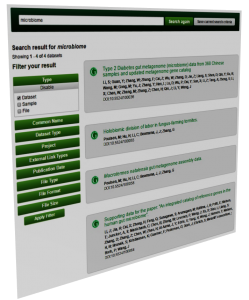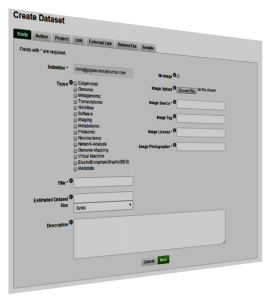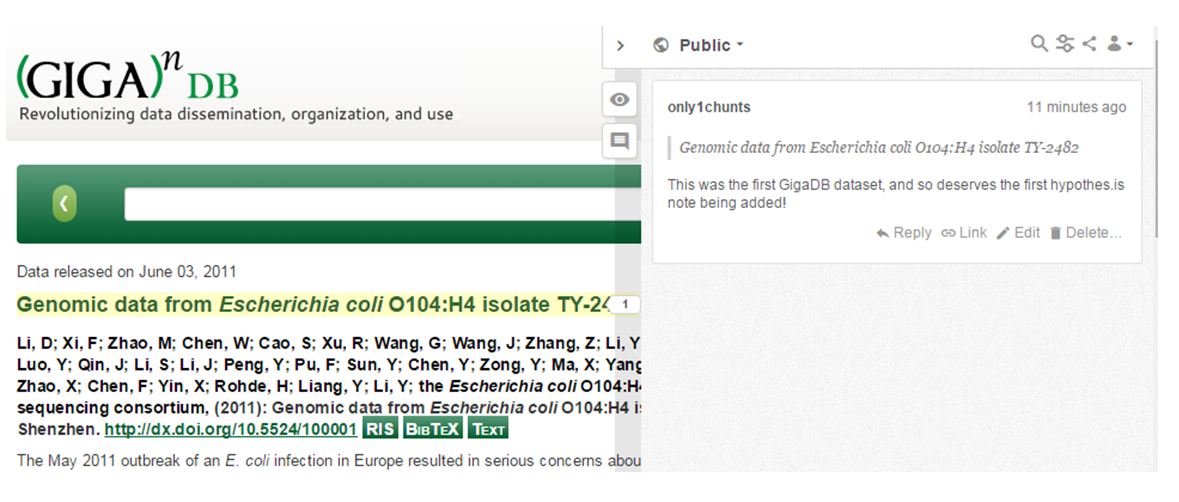GigaScience Gets a Service. What’s new in GigaDB?
Seek and Deploy.
If you’re a user of GigaDB (and why wouldn’t you be!) you’ll perhaps have been wondering why the search function is so slow and often missing obvious results! Well even if you’re not wondering, I can tell you that this has now been fixed. Along with a raft of major under the bonnet changes to the data structure and some additions to the (currently under-used) submission wizard, a new search function and results display, and the integration of the Hypothes.is web-annotation tools have all been implemented in the latest version of GigaDB released last month. These features follow on from the previous version of the database that you can read in some detail in our Database Journal paper, and we have also added additional information on the website such as our advisory board and additional about and FAQ information.
 By far the biggest changes made to GigaDB are to things that the average user will never see, primarily the database schema. We have extended and expanded the schema to allow for future growth in depth and breadth of data types. Some added bonuses of these changes mean we can now link authors between DOIs, link funding information (with a view to further additions allowing full FundRef compliance), as well as link to Google Scholar and EuropePMC to show which papers have cited each dataset (for example dataset 100001 – the deadly 2011 outbreak E.coli O104:H4 genome data of “tweenome” fame links to EuropePMC results showing that it has been directly referenced by 5 articles, and to Google Scholar results showing that it has been referred to by DOIs in 11 articles (as of 26-Jun-2015). Being strong supporters and signatories of the FORCE11 Data Citation Principles, this follows from previous feature additions such as the addition of buttons to allow citation information to be downloaded in RIS, BibTeX and text (see this blog for more).
By far the biggest changes made to GigaDB are to things that the average user will never see, primarily the database schema. We have extended and expanded the schema to allow for future growth in depth and breadth of data types. Some added bonuses of these changes mean we can now link authors between DOIs, link funding information (with a view to further additions allowing full FundRef compliance), as well as link to Google Scholar and EuropePMC to show which papers have cited each dataset (for example dataset 100001 – the deadly 2011 outbreak E.coli O104:H4 genome data of “tweenome” fame links to EuropePMC results showing that it has been directly referenced by 5 articles, and to Google Scholar results showing that it has been referred to by DOIs in 11 articles (as of 26-Jun-2015). Being strong supporters and signatories of the FORCE11 Data Citation Principles, this follows from previous feature additions such as the addition of buttons to allow citation information to be downloaded in RIS, BibTeX and text (see this blog for more).
 In order to remain transparent we now track the history of changes made to each dataset since its publication, and these changes are displayed in date order at the bottom of each dataset.
In order to remain transparent we now track the history of changes made to each dataset since its publication, and these changes are displayed in date order at the bottom of each dataset.
Additional changes to the web-interface include the ability to select which columns are visible in the tables as well as the number of rows to display, and the ability to sort by clicking the column headers.
Submission Mission, and Annotation Creation.
 The submission wizard is designed to walk users through the submission of the dataset metadata, including the addition of author details, sample details and any relevant links to external resources.
The submission wizard is designed to walk users through the submission of the dataset metadata, including the addition of author details, sample details and any relevant links to external resources.
Finally Hypothes.is; the tool to enable a conversations over the world’s online knowledge, has been integrated into all the dataset pages of GigaDB thus allowing users to share comments and annotations on them (see their recent blog for some of the brilliant educational applications).
 So why not have a browse and let us know what you think by using the “contact us” button in the top right of the webpage, we would be very happy to receive all feedback, good or bad!
So why not have a browse and let us know what you think by using the “contact us” button in the top right of the webpage, we would be very happy to receive all feedback, good or bad!
Chris Hunter, PhD. Lead Biocurator, GigaScience.
References
1: Sneddon TP, Zhe XS, Edmunds SC, Li P, Goodman L, Hunter CI. GigaDB: promoting data dissemination and reproducibility. Database (Oxford). 2014 Mar 12;2014:bau018. doi: 10.1093/database/bau018.